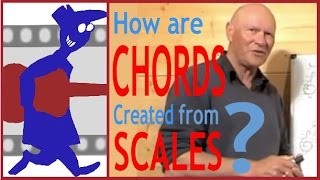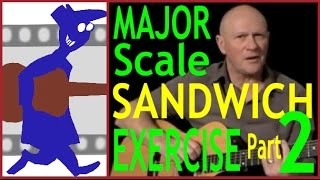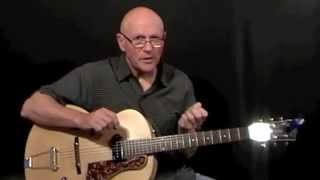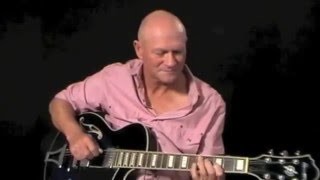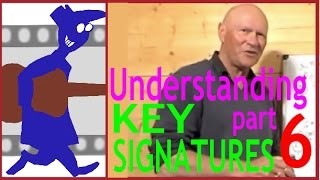Mack the Knife Easy Beginners Jazz Guitar Lesson
Published on 26 January 2016
For more information from the source site of this video please visit:
http://secretguitarteacher.com/youtube/beginner/jazz/DlIth2efMwo/112564560-mack-the-knife-easy-beginners-jazz-guitar-lesson.php
This is a sample of a lesson from the Secret Guitar Teacher site (see link above).
This lesson comes from the Beginners Jazz Course. This course is designed for guitar beginners who would prefer to learn Jazz right from the start instead of taking the more commonly-trodden path of playing blues or rock guitar for a few years first.
So this lesson assumes no prior knowledge or experience of playing the guitar.
Here’s the abridged transcript:
Let’s start with the chords. Here’s F6…First finger on the bottom string at the first fret…With the right hand I want you to either pluck all four notes at once like this…or separate out the bass note from the rest of the chord using thumb and fingers like this. Ok, we play that for four beats, then it’s on to Gm7 which looks like this
In the third bar we keep the Gm7 chord going for another couple of beats before changing to C9 for just two beats…Again we start this shape on the second finger at fret 3 on the fifth string…and then add the first finger at fret 2 on the 4th string and make a mini-barre with the 3rd finger across the 3rd and 2nd strings at fret . We’re then back to the F6 chord for a whole bar at the end of the first line.
OK on to the second line which starts with a chord called F slash A. This is shorthand for the chord of F major played with A in the bass, sometimes we say F over A. It looks like this…
Notice that only three notes are sounded in this chord, the fifth string and top two strings are marked with little ‘x’ s to show they should be omitted or muted. Also notice that I have suggested using fingers 1 3 and 4 on the fretting hand.
This fingering works for me, but if you have larger hands you may prefer using fingers 1 2 and 3 or even 1 2 and 4. Try each option and decide which works best for you.
This chord is only held for two beats before we shift down to Ab diminished - the little superscript circle next to the flat sign means diminished.
So from this shape the F/A we simply need to move these two finger down
So far this second line looks like this. Then we need anGb7 chord for just two beats. We can use this shape for that chord. First finger on the bottom string at the second fret…second finger on the 4th string at the same fret and 3rd finger on the 2nd fret at the same fret…so notice that we are simply fingering each alternate string here at fret 2 ..and then we add the pinky here at fret 3 on the 3rd string .
Ok we’re nearly there…the last bar returns us to the F6 and then we throw in a C7 as what we call a turnaround chord.
Here you can see that after the C7 chord there is a little symbol made of two lines and two dots - you may recognize this as a repeat sign. It simply means start again from the beginning of the sequence - usually for the next verse or chorus of the song. Here’s the diagram for C7
This time we start with our 1st finger on the second string 1st fret 2nd finger fret 2 on the 4th string, 3rd finger 3rd fret 5th string and then add the pinky at fret 3 on the 3rd string .
OK here’s the second line of the sequence in slow motion starting with the F/A chord for just two beats then changed to the Ab diminished chord just two beats then the Gm7 for a whole bar then hang on to the Gm7 for the first 2 beats of the next bar before moving down to Gb7 for two beats where the sequence resolves back to F6, but then we jump to the C7 to indicate that we are going back to the beginning - the turnaround chord .
Once you can play through the changes smoothly enough, only then is it really worth turning your attention to the actual comping pattern.
Once you begin to feel happy with that, try the approach I showed you earlier of separating out the thumb from the fingers to get a sort of oompah rhythm going like this:
What this will do is help you understand the concept of playing on the upbeat. The upbeat is the beat we are counting ‘and’ on.
So with this comping pattern the thumb is taking care of main beats and the fingers are looking after the upbeats. To help you put this into effect I have made a special type of backing track to go with this lesson. It’s actually a kind of reverse of most backing tracks in that it leaves out the rhythm part so that you can fill that in. I call this a ‘Fronting track’.
If you are watching this as a member of the secret Guitar Teacher site then you can access the full-length fronting track from the toolbox to the right of the screen.
In the next lesson we’ll turn our attention to playing the melody. I look forward to seeing you for that.
 Jazz Guitar Licks: The Bebop Lick - the one line e...
Jazz Guitar Licks: The Bebop Lick - the one line e...
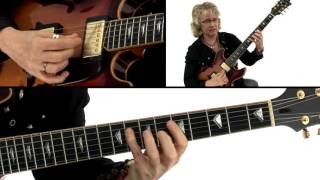 Bebop Etudes Guitar Lesson - Reflections One Break...
Bebop Etudes Guitar Lesson - Reflections One Break...
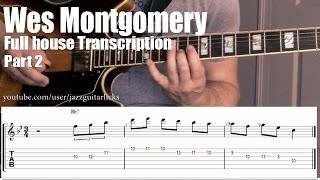 Wes Montgomery jazz guitar lesson with tab | "Full...
Wes Montgomery jazz guitar lesson with tab | "Full...
 Bebop Etudes Guitar Lesson - Reflections One Overv...
Bebop Etudes Guitar Lesson - Reflections One Overv...
 Fusion Licks Volumen 2 - (Menor Melódica & Impr...
Fusion Licks Volumen 2 - (Menor Melódica & Impr...
 Minor jazz guitar lick with tab
Minor jazz guitar lick with tab
 Major II-V-I jazz guitar lesson | Lick # 2
Major II-V-I jazz guitar lesson | Lick # 2
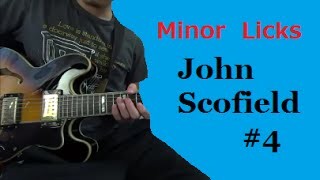 Minor Licks - John Scofield #4 ã€ÂAdvanced Gui...
Minor Licks - John Scofield #4 ã€ÂAdvanced Gui...
 Downtown Shuffle 1 + 2 from my book "Bluesmans Co...
Downtown Shuffle 1 + 2 from my book "Bluesmans Co...
 Modern Jazz Improv - #2 Ionian & Lydian Arpeggios...
Modern Jazz Improv - #2 Ionian & Lydian Arpeggios...

